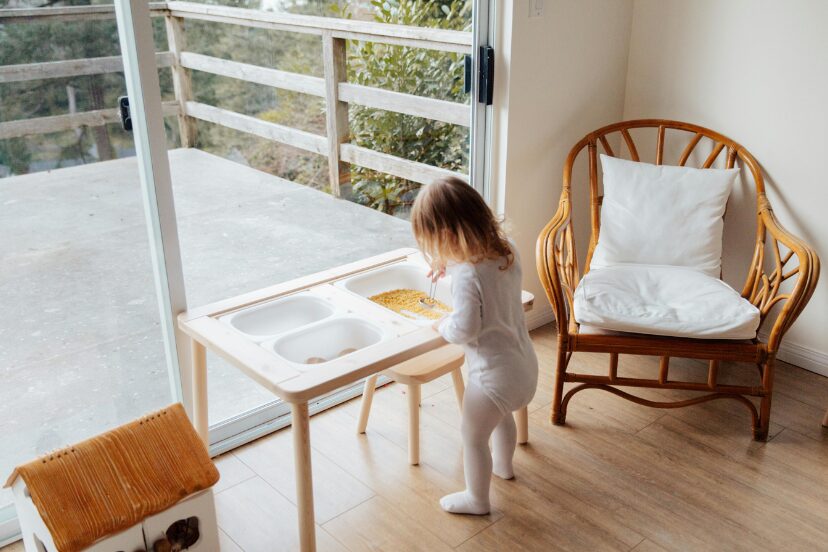Sensory tables, also known as a tabletop discovery stations, are tables with shallow containers that you can fill with different materials that will stimulate a child’s senses. They typically come in various sizes and shapes, and are often used in classrooms, therapy settings, or at home to promote sensory exploration, learning, and development.
The Best Sensory Tables: Our Top Picks
1. The Wingyz Sensory Table
- Our first pick, the Wingyz Sensory Table, takes the cake for its versatility, durability, and features. It features 3 removable plastic bins to fill with whatever you like and versatile bin covers/table top.
- The table top has reversible sides where you can choose to make it a full chalkboard, full art table, or half and half. It also has a refillable paper roll that turns the table into an instant canvas.
- The classic wood design features safe edges and is easy to clean with a quick wipe down. If you’re looking for a versatile well made sensory table this may be the one for you!
2. Edxeducation Sand and Water Sensory Table
- The Edxeducation Sand and Water Sensory Table our runner up choice. This table provides a large play area and has the space to accommodate multiple people to play comfortably at the same time.
- This table is really pretty and the transparent play bin adds a nice sensory aesthetic. The dry trays double as shelves or lids which helps keep things clean and organized.
- With it’s robust design and steel frame, this table can stand the toddler test. It’s equipped with rolling wheels which makes it easy to move around even when it’s full. If you’re looking for a solid sensory table with a large play area this one may be a good fit.
3. Special Supplies Sensory Activity Table
- The Special Supplies Sensory Activity Table has a simple design that is customizable and adjustable. It features 4 grow with me adjustable leg heights from 18″ to 25” sizes. The bins can be separate or clipped together for a customized setup.
- Because of its simple design, this sensory table won’t take up a lot of floor area so it’s a good choice for folks with limited space. Each bin has a separate snap tight lid so everything stays in the bins when not in use which so nice for keeping thing clean.
- The design may be compact but it does not lack sturdiness or durability. It features enhanced stability so the bins don’t wobble or move while in use. If your looking for a compact but functional sensory table then look no further!
How do They Work?
Sensory tables work by providing a safe and engaging environment for children to explore different textures, smells, sounds, and visual stimuli. The materials inside the table can be manipulated, sorted, and explored, encouraging children to use their senses to learn about the world around them.
Types of Sensory Tables:
- Water Tables: Filled with water, these tables often include toys, cups, and funnels, allowing for splashing and pouring activities.
- Sand Tables: These encourage digging, building, and sifting through sand, often enriched with scoops, molds, and toys.
- Sensory Bins: Smaller and more portable than traditional sensory tables, these bins can be filled with a variety of materials like dried rice, beans, or cornmeal.
- Themed Tables: These include seasonal or themed materials (e.g., autumn leaves, holiday decorations) to encourage role play and creative storytelling.
- Filler Tables: These tables can contain a mix of different textures, promoting a wider range of sensory experiences in one setting.
- Tables with Lights: These tables have light incorporated into the design which can create a unique visual effect.
What Kinds of Things Can I Fill a Sensory Table With?
They can be filled with a variety of materials such as sand, water, rice, beans, pasta, shaving cream, play-dough, water beads, or even natural materials like leaves, rocks, and twigs. The sky is the limit! The goal is to encourage exploration, creativity, and sensory processing skills.
What are the Benefits of Sensory Tables?
Sensory tables offer numerous benefits for children, including:
- Improved fine motor skills: Manipulating materials in the sensory table helps develop hand-eye coordination and finger dexterity.
- Enhanced cognitive development: Sensory play encourages problem-solving, critical thinking, and creativity.
- Emotional regulation: Sensory play can be calming and soothing, helping children manage stress and anxiety.
- Language development: As children explore and play with different materials, they learn new vocabulary and practice communication skills.
- Social skills: Sensory tables can be used in group settings, fostering cooperation, sharing, and taking turns.
Which Kind of Sensory Seekers Would Like Them?
Sensory tables work by providing children with a variety of tactile, visual, auditory, and sometimes even olfactory and gustatory experiences. Sensory tables are particularly beneficial for children with sensory processing disorders, autism, or other developmental delays. However, all children can benefit from sensory play, as it helps them learn about their environment and develop essential skills.
Sensory tables offer children an engaging way to explore their environment and learn essential skills while having fun. Whether in a classroom setting, at home, or in a playgroup, these tables can provide endless opportunities for exploration, creativity, and growth. So, unleash the power of sensory play and watch as children joyfully discover the world around them!
Similar Things People Might Like:
- Playdough or clay: These moldable materials offer tactile experiences and promote creativity and fine motor skills.
- Art supplies: Painting, drawing, and crafting activities can stimulate a child’s senses and encourage exploration and self-expression.
- Fidget toys: These small, handheld objects can help children regulate their sensory needs and improve focus and concentration.
- Sensory bottles: Clear plastic bottles filled with different materials, such as glitter, water, and food coloring, that create a calming visual effect when shaken or tilted.


